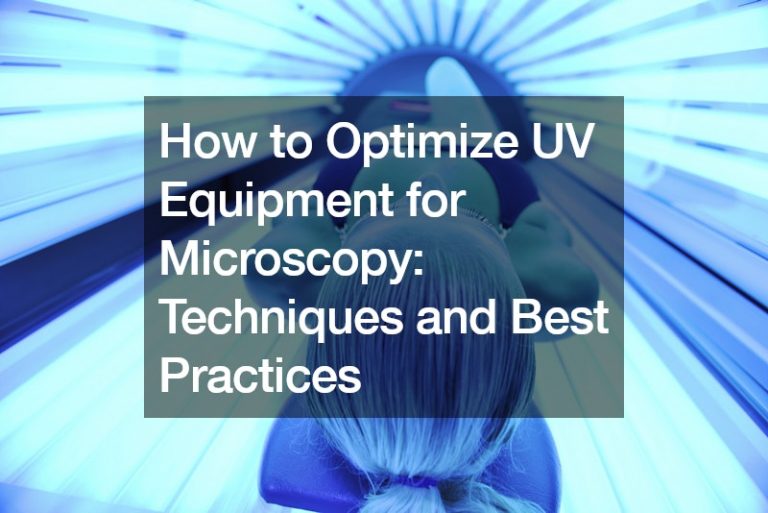In the world of microscopy, using UV (ultraviolet) equipment has revolutionized our ability to observe and understand microscopic organisms and structures. UV equipment plays a crucial role in scientific research, from uncovering intricate details of cellular processes to investigating environmental phenomena. However, to harness the full potential of UV microscopy, it is essential to optimize equipment settings and employ best practices.
In this article, we will explore techniques and strategies for maximizing the effectiveness of UV equipment in microscopy applications.
Understanding UV Equipment: Before delving into optimization techniques, it’s important to understand the components of UV equipment. UV microscopes typically consist of a light source capable of emitting UV radiation, specialized filters to control the wavelength of light, and detectors to capture the resulting fluorescence. These components work together to illuminate specimens with UV light and visualize fluorescent signals.
Proper Setup and Calibration: One of the first steps in optimizing UV equipment is ensuring proper setup and calibration. This involves aligning the UV light source, adjusting the intensity settings, and calibrating the wavelength to suit the specific requirements of the experiment. Careful calibration ensures accurate imaging and minimizes the risk of phototoxicity – a phenomenon where UV exposure damages living cells.
Adjusting Settings for Specific Objectives: Different research objectives may require adjustments to UV equipment settings. For example, researchers studying live-cell imaging may need to optimize UV intensity to minimize photodamage while obtaining clear fluorescence signals. Similarly, experiments focusing on specific cellular structures or organelles may require fine-tuning wavelength settings to enhance contrast and resolution.
Minimizing Phototoxicity: Phototoxicity is a common concern in UV microscopy, particularly when imaging live cells or organisms. To minimize photodamage, using the lowest possible UV intensity that still provides adequate fluorescence signals is important. Additionally, limiting exposure time and incorporating intervals of darkness between imaging sessions can help mitigate the effects of phototoxicity.
Managing UV Exposure: Proper management of UV exposure is essential for maintaining the health and viability of specimens. When imaging live cells, monitoring UV exposure time and adjusting settings accordingly to prevent cell damage is important. Additionally, using UV-blocking filters or shielding techniques can help protect sensitive samples from excessive UV radiation.
Maintaining Equipment: Regular maintenance of UV equipment is crucial for ensuring consistent performance and longevity. This includes cleaning optical components, replacing worn-out filters or bulbs, and conducting routine inspections for signs of wear or damage. Researchers can avoid unexpected disruptions and ensure reliable results by keeping UV equipment well-maintained.
Troubleshooting: UV equipment may encounter occasional issues despite careful optimization and maintenance. Understanding common troubleshooting techniques can help researchers quickly identify and resolve problems. Whether it is adjusting alignment, troubleshooting electrical connections, or consulting equipment manuals, having troubleshooting skills is essential for overcoming challenges in UV microscopy.In addition to its applications in research laboratories, UV equipment plays a vital role in healthcare settings, particularly hospitals. UV technology is increasingly being utilized in hospitals for disinfection purposes, aiding in preventing healthcare-associated infections (HAIs) and enhancing overall patient safety. Here is how UV equipment is being used in hospitals and healthcare facilities:
UV Disinfection of Surfaces: Hospitals are high-traffic environments where pathogens can easily spread from surfaces to patients and healthcare workers. UV disinfection systems, such as UV-C robots or portable UV disinfection devices, are employed to sanitize patient rooms, operating theaters, and other high-touch surfaces. These devices emit UV light at specific wavelengths known to be effective against a wide range of pathogens, including bacteria, viruses, and fungi, helping to reduce the risk of HAIs and maintaining a clean healthcare environment.
Sterilization of Medical Equipment: UV equipment is also used for the sterilization of medical instruments and equipment. UV sterilization chambers or cabinets are designed to kill microorganisms on surfaces of medical devices, such as surgical instruments, endoscopes, and respiratory equipment. This non-contact sterilization method provides an alternative to chemical disinfectants and autoclaving, ensuring the efficacy and safety of medical equipment for patient care.
Airborne Pathogen Control: UV technology is employed in air purification systems to control airborne pathogens within hospital environments. UV air disinfection units, installed in HVAC systems or standalone air purifiers, utilize UV-C light to inactivate airborne viruses, bacteria, and mold spores, reducing the risk of airborne transmission of infectious diseases and improving indoor air quality for patients and staff.
UV Safety Measures: While UV equipment offers significant benefits for infection control, it is essential to implement safety measures to prevent potential harm to patients and healthcare workers. Proper training on the safe use of UV equipment, including protocols for room preparation, monitoring UV exposure levels, and ensuring adequate ventilation, is essential to minimize risks and ensure safe and effective disinfection practices in healthcare settings.
In summary, UV equipment plays a crucial role in hospitals and healthcare facilities, contributing to infection prevention, patient safety, and environmental hygiene. By harnessing the power of UV technology, hospitals can enhance their infection control measures, reduce the spread of pathogens, and create safer environments for patient care. Continued research and innovation in UV disinfection techniques will further advance the use of UV equipment in healthcare, ultimately improving patient outcomes and reducing healthcare-associated infections.
.




